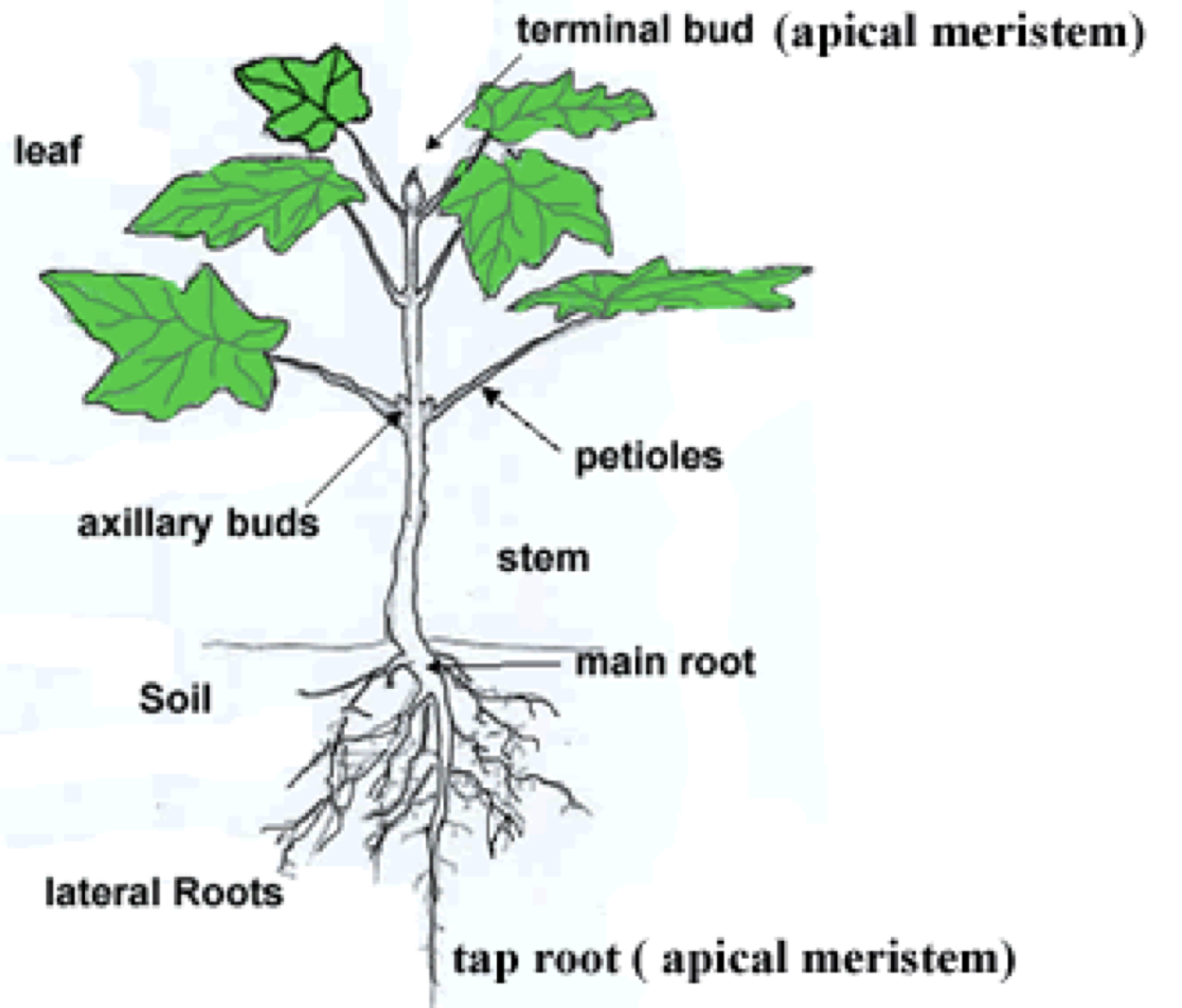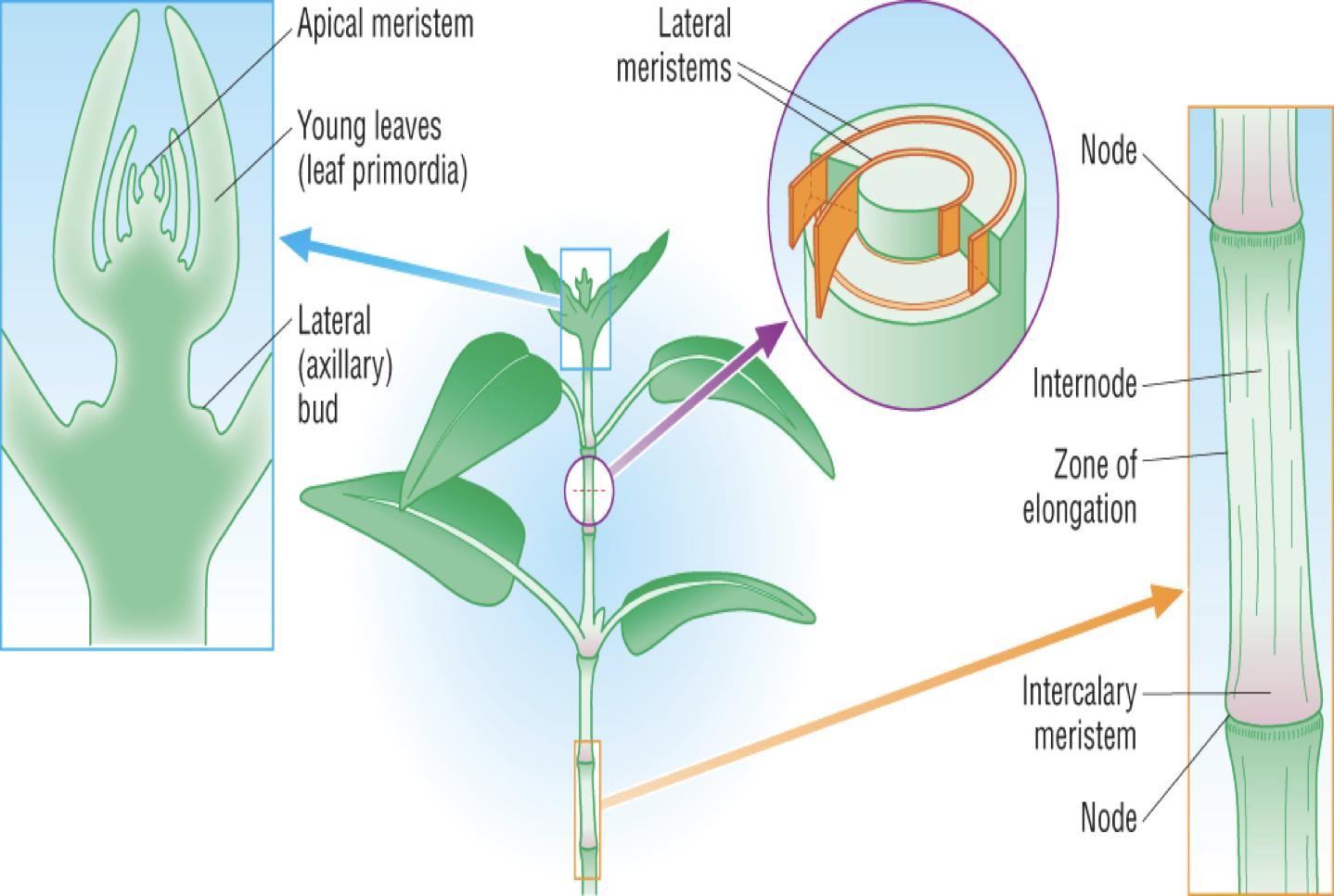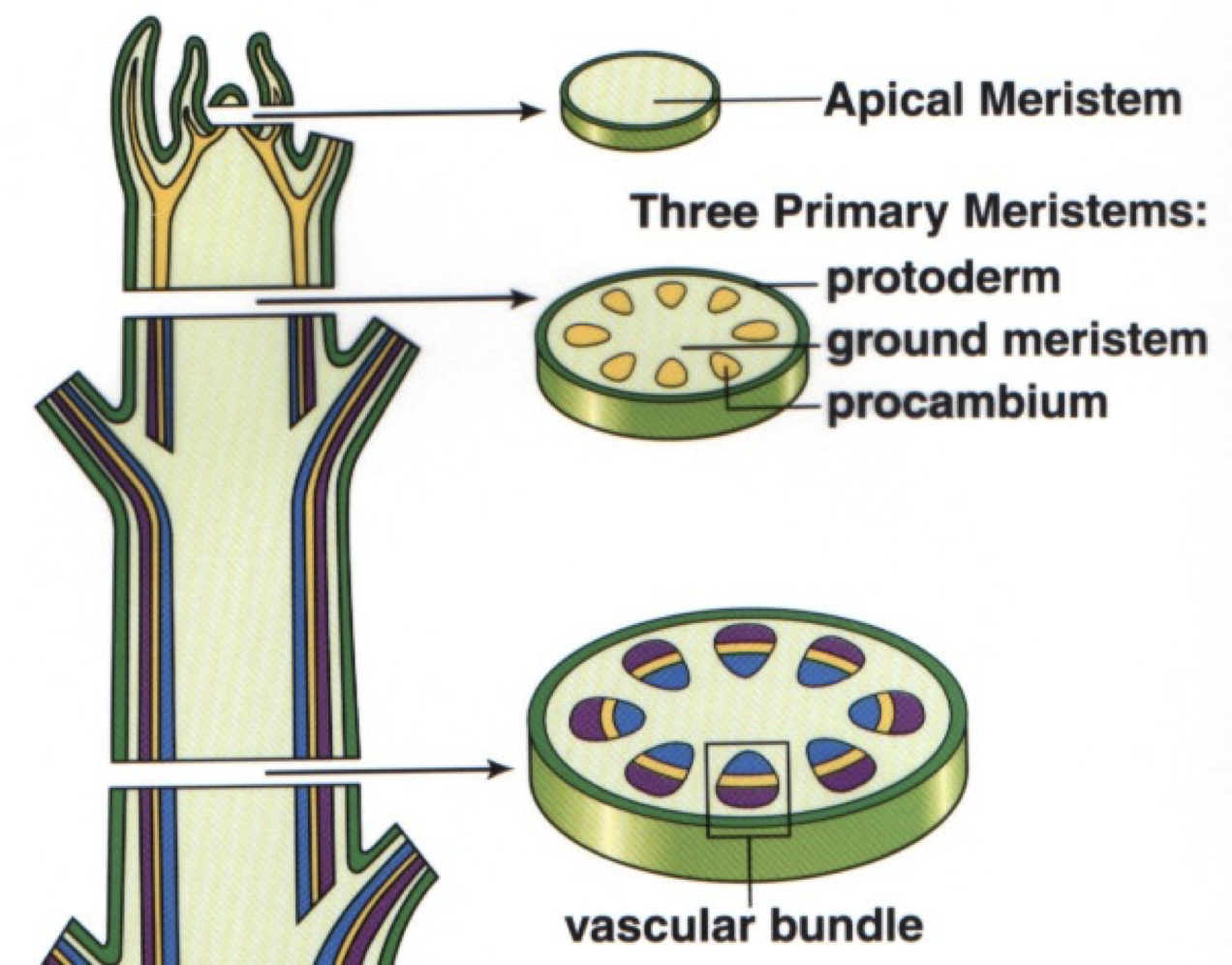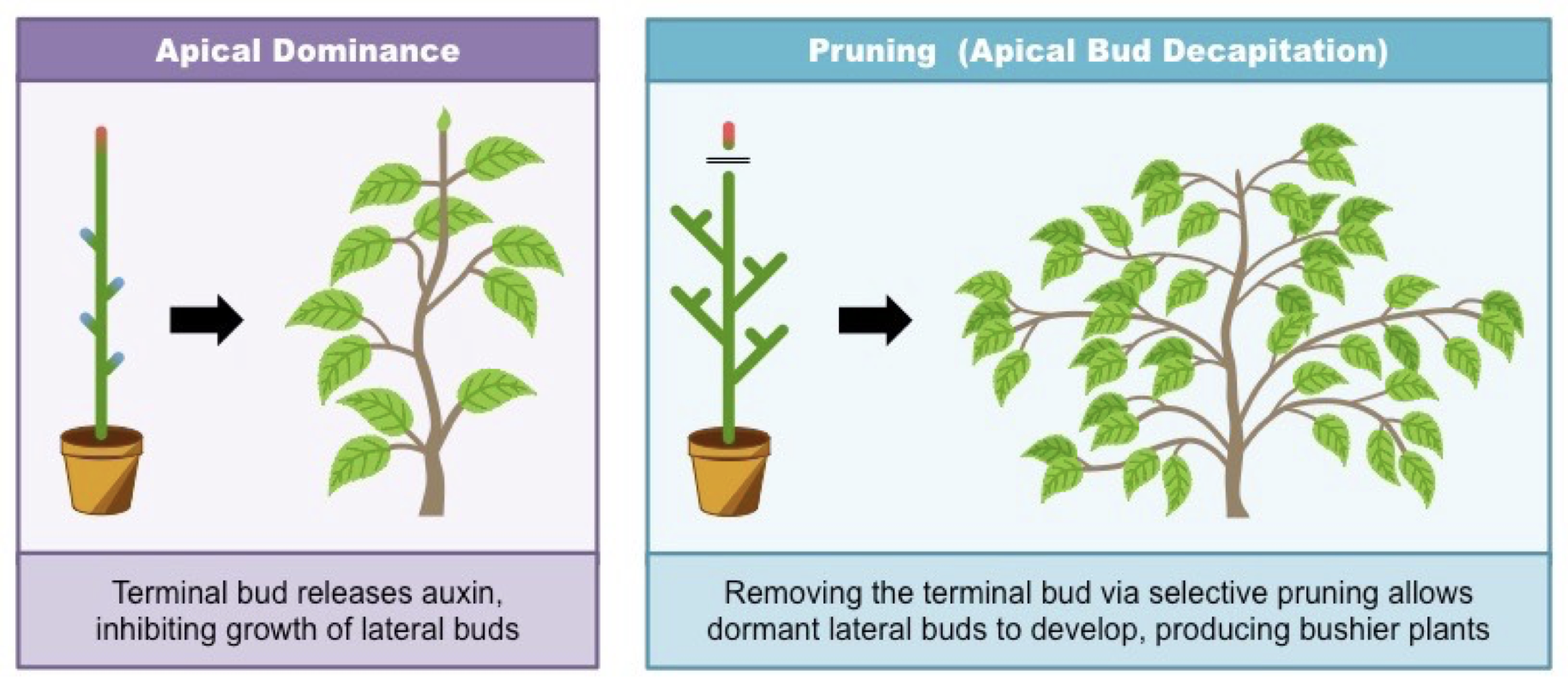
meristems
plant cells have meristematic stem cells that are always in plant, can make any type of cell (totipotent)
meristems: region of unspecialized plant tissue/cells, found chiefly at growing tips of roots and shoots and in the cambium, consisting of actively dividing cells forming new tissue
where does plant growth occur
plants cell wall limits ability to divide + expand
growth therefore only occurs where there are immature cells e.g. the meristem


types of meristem
Apical meristems
at the tips or apex of roots and shoots
results in longer roots and shoots
Lateral bud meristems
in buds and could give rise to side shoots
Lateral meristems
found in a cylinder near the outside of roots and shoots
cause them to widen
Intercalary meristems
located between nodes
makes the shoot longer

apical dominance
dicotyledonous plants have apical meristems (undifferentiated cells)
apical bud of plant is primary growing point located at apex (tip) of the stem
it is the dominant bud, since it can cause all the lateral buds below them to remain dormant
terminal buds have special tissue called apical meristem. these cells can divide indefinitely and produces all the differentiated tissue
growth of this bud exhibits apical dominance - it inhibits growth of lateral buds
auxin role in apical dominance
auxins are also known to play a role in apical dominance - high auxin conc stimulates growth at apical shoot + inhibits growth of lateral shoots. plants then grow taller and compete more efficiently for sunlight
this is known as APICAL DOMINANCE
if terminal or apical tip of plant is removed, then lateral buds elongate and grow
(also regardless of genotype more gibberellin means more lateral growth)
apical dominance: terminal bud releases auxin inhibiting the growth of lateral buds
pruning (apical bud decapitation): removing the terminal bud via selective pruning allows dormant lateral buds to develop, producing bushier plants

controlling apical dominance
imposed by young leaves of apical bud
these synthesise indoleacetic acid (IAA)
IAA inhibits growth of buds below
if apical bud removed, one or more lateral buds take over
if apical stump is treated with IAA, growth of lateral buds is suppressed
why?
auxin in the apical bud is transported down the shoot through the cells and accumulates at the nodes where its presence inhibits growth of the nearby lateral buds. This prevents the lateral bud competing with the apical tip for light and nutrients.
PROOF
If apical bud removed – the lateral buds grow, and the plant grows sideways.
If the bud is removed and synthetic hormone IAA applied to the cut, the lateral buds don’t grow.
auxins
plant hormones used to control growth, acts as growth promoter
causes increased transport of hydrogen ions from cytoplasm to cell wall
this activates enzymes expansins which breaks crosslinks between cellulose fibres
increasing cell wall flexibility
cells expand as they absorb water
auxin also alters gene expression to promote cell growth
how they are produced
auxins produced at apex + then diffuse or actively transported to the cells in zone of elongation → they elongate, shoot grows
gibberellin
cause stem elongation, concentration affects internodes
discovered as they are produced by fungus from genus Gibberella
infected rice seedlings grew extremely tall and thin
dwarf plants produce little/no gibberellin
meristems
plant cells have meristematic stem cells that are always in plant, can make any type of cell (totipotent)
meristems: region of unspecialized plant tissue/cells, found chiefly at growing tips of roots and shoots and in the cambium, consisting of actively dividing cells forming new tissue
where does plant growth occur
plants cell wall limits ability to divide + expand
growth therefore only occurs where there are immature cells e.g. the meristem


types of meristem
Apical meristems
at the tips or apex of roots and shoots
results in longer roots and shoots
Lateral bud meristems
in buds and could give rise to side shoots
Lateral meristems
found in a cylinder near the outside of roots and shoots
cause them to widen
Intercalary meristems
located between nodes
makes the shoot longer

apical dominance
dicotyledonous plants have apical meristems (undifferentiated cells)
apical bud of plant is primary growing point located at apex (tip) of the stem
it is the dominant bud, since it can cause all the lateral buds below them to remain dormant
terminal buds have special tissue called apical meristem. these cells can divide indefinitely and produces all the differentiated tissue
growth of this bud exhibits apical dominance - it inhibits growth of lateral buds
auxin role in apical dominance
auxins are also known to play a role in apical dominance - high auxin conc stimulates growth at apical shoot + inhibits growth of lateral shoots. plants then grow taller and compete more efficiently for sunlight
this is known as APICAL DOMINANCE
if terminal or apical tip of plant is removed, then lateral buds elongate and grow
(also regardless of genotype more gibberellin means more lateral growth)
apical dominance: terminal bud releases auxin inhibiting the growth of lateral buds
pruning (apical bud decapitation): removing the terminal bud via selective pruning allows dormant lateral buds to develop, producing bushier plants

controlling apical dominance
imposed by young leaves of apical bud
these synthesise indoleacetic acid (IAA)
IAA inhibits growth of buds below
if apical bud removed, one or more lateral buds take over
if apical stump is treated with IAA, growth of lateral buds is suppressed
why?
auxin in the apical bud is transported down the shoot through the cells and accumulates at the nodes where its presence inhibits growth of the nearby lateral buds. This prevents the lateral bud competing with the apical tip for light and nutrients.
PROOF
If apical bud removed – the lateral buds grow, and the plant grows sideways.
If the bud is removed and synthetic hormone IAA applied to the cut, the lateral buds don’t grow.
auxins
plant hormones used to control growth, acts as growth promoter
causes increased transport of hydrogen ions from cytoplasm to cell wall
this activates enzymes expansins which breaks crosslinks between cellulose fibres
increasing cell wall flexibility
cells expand as they absorb water
auxin also alters gene expression to promote cell growth
how they are produced
auxins produced at apex + then diffuse or actively transported to the cells in zone of elongation → they elongate, shoot grows
gibberellin
cause stem elongation, concentration affects internodes
discovered as they are produced by fungus from genus Gibberella
infected rice seedlings grew extremely tall and thin
dwarf plants produce little/no gibberellin
 Knowt
Knowt